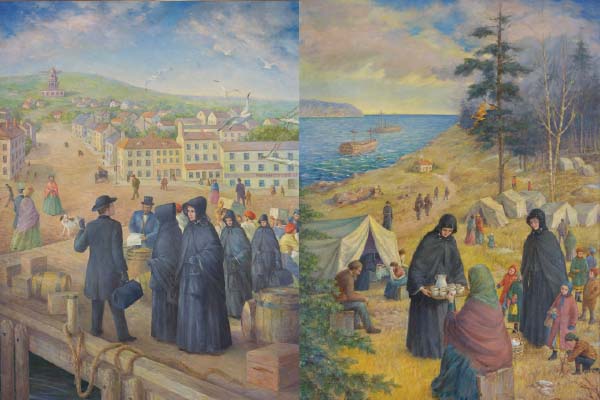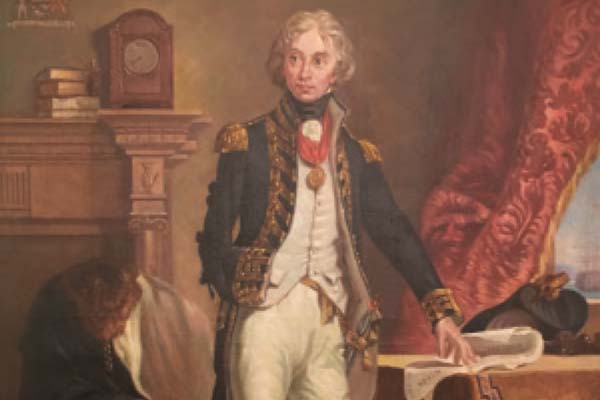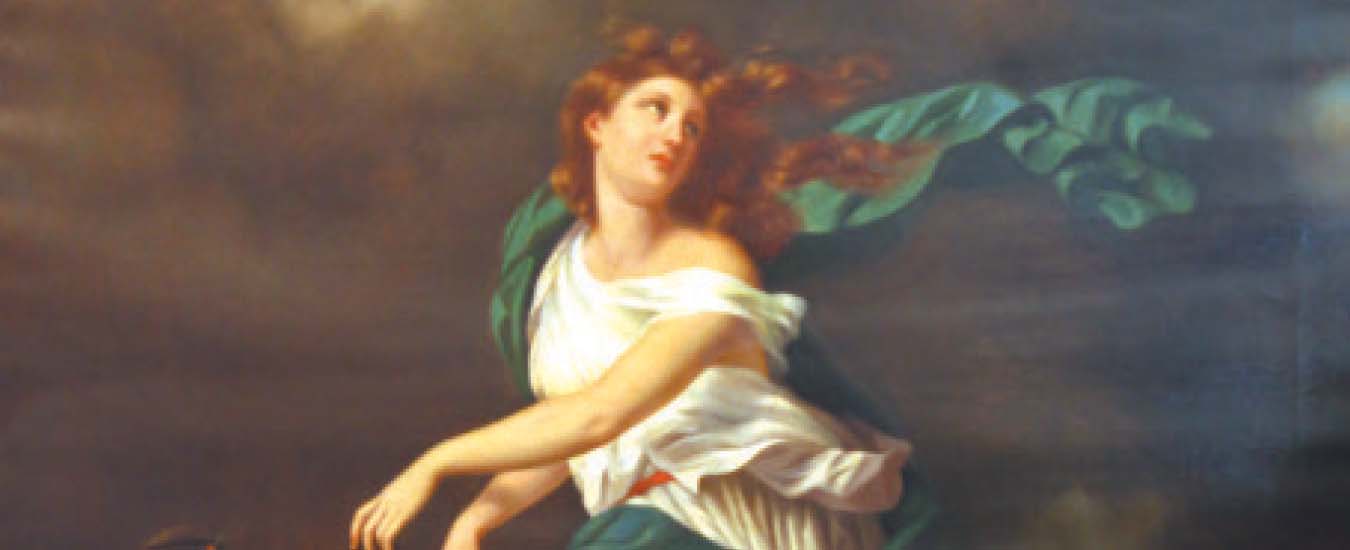The unfolding story of an artist
It’s 1896. Leo Hirschfield introduces the Tootsie Roll; the words “Yukon” and “gold rush” become synonymous; and the first American-made gasoline automobile makes its debut. It’s also the year that 17-year-old Julia Alma Landry from the village of Eel Brook, Nova Scotia, makes the arduous journey to Halifax to join the Sisters of Charity.
Little did Julia know that she would eventually travel to Italy to study with Filadelfo Simi, a world-renowned Italian painter and sculptor, nor that she would end up at the Motherhouse at Mount Saint Vincent creating her own masterpieces, and that sadly, much of her life’s work would go up in flames. Yet, thanks to her great niece, Gaynor Kleiber, her story lives on.
A budding artist
Julia was born in Bouctouche, NB, in 1879. She was the daughter of the first Acadian doctor in the Maritimes—Alexandre Pierre Landry and his wife Genevieve Bourque. Dr. Landry moved his medical practice and family to Eel Brook, NS, five years later. Growing up, Julia loved to paint and draw, and her parents encouraged this.
It was difficult for girls to get a higher education in Nova Scotia in the late 1800s but it was common practice in Roman Catholic communities for young women to become nuns. The Sisters of Charity were progressive. They encouraged the novices to develop their skills, get an education, and become teachers.
The order started in the US in 1809 when Elizabeth Ann Seton founded the Sisters of Charity (of St. Joseph’s) in Emmitsburg, Maryland. The sisters established orphanages and schools and worked extensively with the downtrodden in various parts of the US.
In 1849, Bishop Walsh from the Roman Catholic Diocese in Halifax asked the Sisters of Charity in the US to send some nuns to Nova Scotia, primarily to teach the children of poor Irish immigrants. Four nuns arrived by ship in the same year. In short order, large numbers of children were going to school; many became nuns.
Fast forward to 1873 when Mount Saint Vincent Academy was established in Bedford. At the time, it was one of the only institutions of higher learning for women in Canada. Although the original purpose of the academy was to help novices and nuns become teachers, the Sisters also recognized the need to educate young women from all walks of life, so they opened the academy to other women.

Left: Arrival of the Sisters of Charity in Halifax, depicting their arrival in 1849. Right: Caring for the Sick on McNabs Island tells the story of what happened in a disease outbreak in 1866. Credit: Fred Horton
Julia no more
By the age of 17, Julia Alma Landry had decided to become a nun. Hence her journey to the Mount in 1896. After completing her vows and studies four years later, Julia—now Sister Agnes Berchmans—was assigned to a convent in Boston where a priest by the name of Father Gallagher recognized her artistic talent. Eventually, he made arrangements for the young nun to travel to Italy to study with master painter Filadelfo Simi.
Sister Agnes Berchmans spent the better part of two years (1906-7) in Florence, being tutored by Simi. She also met Pope Pius X in Rome, and later painted his portrait. After returning to Boston, she taught and painted at the Academy of the Assumption in Wellesley Hills. She also created works of art for private collectors, commissioned through the church. In 1928 she was reassigned to what had become Mount Saint Vincent College, where her main task was to produce art for the Motherhouse chapel.
Over the next 20 years, Sister Agnes Berchmans created 135 paintings for the chapel. She was also commissioned to do works for the Lord Nelson Hotel (two paintings of Lord Nelson, which still grace the premises); artwork for the Halifax Infirmary; and countless works for private collectors and families, including portraits of Sydney C. Oland of Oland’s Brewery and Graham W. Dennis, founder of The Chronicle Herald.
Then it happened. A fire on January 31, 1951 consumed the Motherhouse, including the contents of the chapel. Sister Agnes Berchmans was 72 years old. But with renewed zest she made a special effort to recreate some of the paintings that were destroyed.
For example, one depicts the Sisters’ arrival in Halifax in 1849. In the foreground of the painting are the four nuns and in the background is the town clock, Citadel Hill, and Halifax streetscape including 52 people and two dogs. The arrival of the Sisters of Charity was declared a National Historic Event in 2008. Another painting depicts the Sisters on McNabs Island in 1866. The SS England, bound for New York, was diverted to Halifax after a cholera epidemic broke out on board. Three Sisters went to McNabs to care for the orphans and the sick. Both paintings are large: 172.7 cm by 122 cm (68 inches x 48 inches). With the frames, they are gigantic.

One of two paintings of Lord Nelson on display at the Halifax hotel bearing his name.
Collecting Sister Agnes’ art
Sister Agnes Berchmans died in 1973 at the age of 93. Today, 27 of her paintings are at the Sisters of Charity Centre (most on display) as well as two wood carvings, one wooden pedestal and a cross stitch. The collection includes the Christ Child, mounted in a gold embroidered cross set in a white satin background, a small piece miraculously discovered after the fire—attached to the inside of the Tabernacle.
Several years ago, Gaynor Kleiber embarked on a mission to find some of “Sister AB’s” paintings, lovingly referring to her great aunt. In 2005, while cruising the web, four painting popped up on the site of an auction house in Louisiana. Alas, by the time Gaynor discovered this, they were sold.
In the summer of 2010, Gaynor received notice that five more of her great aunt’s paintings were for sale at James D. Julia Auctioneers in Fairfield, ME. The date of the auction was the 25th of August; she and her husband John Thompson lost no time planning a road trip.
The painting that captured Gaynor’s imagination was Philomena. The auction catalogue described it as: “A large unframed oil on canvas. [This] allegorical scene shows a woman holding an anchor on a rock bracing herself against an oncoming storm, with a coastal castle beyond. The scene depicts the Princess who denied her suitor, stating she had given herself to Christ.”
On the day of the auction, people from all over the world cast their bids. “I bid $1,200 on Philomena,” Gaynor says, “and just about fell off my chair when the bidding closed—she was mine! I’ll never forget that moment. Sister AB and I both had red hair when we were young. To me that clinched the deal. I have her in my home and she’s very special.”
Gaynor has often wondered if Philomena was a self-portrait painted by her great aunt. “Like the description of the painting, she may have had a suitor,” she says, “but chose the religious life instead.”
Five months later, Gaynor mounted an exhibit at the Yarmouth County Museum titled “Generations.” It featured the work of four family members spanning three generations of artists—her photographer brother, Fred Horton; her mother JoAnn (Landry) Horton, her aunt Mary (Landry) Dowler who both paint, and her great aunt Sister Agnes Berchmans. During the opening, Philomena was officially unveiled.
Since this exhibition in Yarmouth, other paintings have surfaced from distant relatives and information has come forth from people all over the world who have some connection to Sister AB. Gaynor is having a whale of a time collecting it all, and intends to write a book. Sister Agnes Berchmans’ story continues to unfold.
